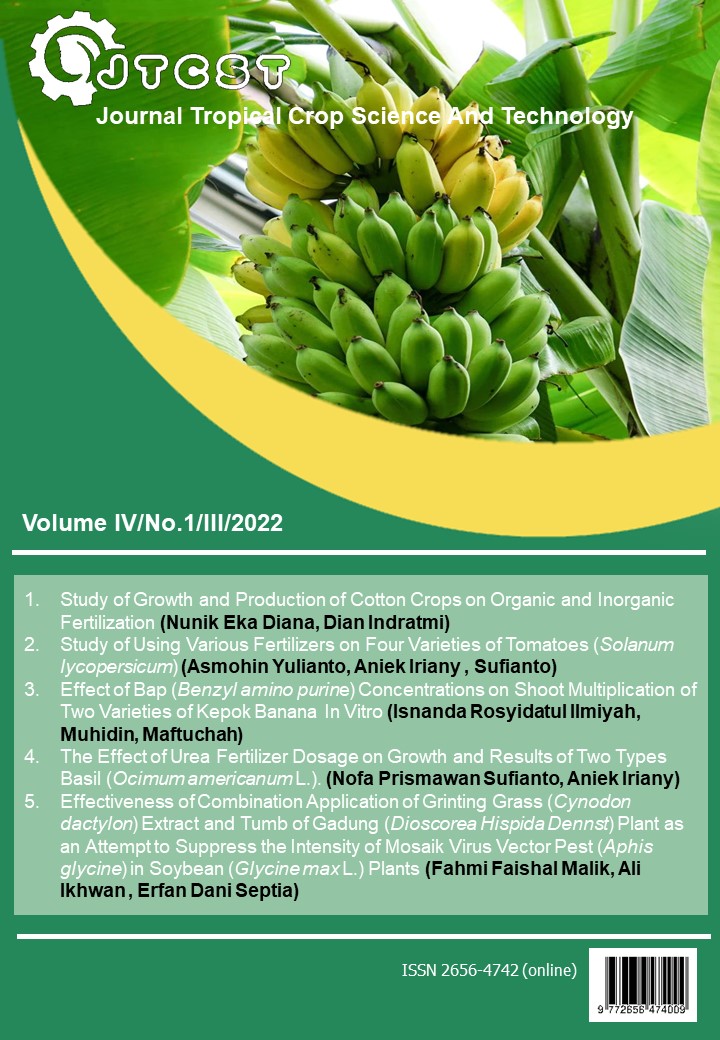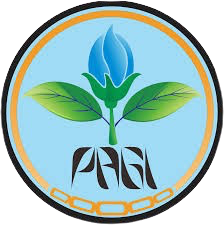Study of Using Various Fertilizers on Four Varieties of Tomatoes (Solanum lycopersicum)
DOI:
https://doi.org/10.22219/jtcst.v4i1.29742Keywords:
Tomatoes, Varieties, Fertilizers, Combination, Growth of PlantAbstract
The increasing demand for tomatoes has prompted concerns about the potential decrease in tomato supply, as reflected in rising market prices. To address this issue, efforts should be directed towards enhancing the productivity of tomato plants. This study focuses on identifying the interactive effects of fertilizer type and tomato variety on tomato plant development.Utilizing a Completely Randomized Design (CRD) with two factors, the first factor involves three types of fertilizers (Goat Manure, NPK, and Liquid Organic), while the second factor includes four tomato varieties (Permata, Donna, Serfo F1, and Tinatoon F1). Various parameters, such as plant height, number of leaves, number of branches, stem diameter, number of fruits, and fruit weight, were monitored.The study's results highlight a significant interaction between fertilizer types and tomato varieties, with the NPK fertilizer treatment and the Tinatoon F1 variety demonstrating optimal height among the tomato plants. Notably, NPK fertilizer exhibited a positive influence on tomato plant development, particularly in plant height at weeks 7, 10, and 13, as well as in the number of leaves, number of branches, fruit weight, and stem diameter. In contrast, the type of tomato plant did not significantly impact tomato growth, except for the Tinatoon Variety, which consistently outperformed others in terms of branches, leaves, stem diameter, and fruit weight during the observation period at weeks 7, 10, and 13. These findings underscore the importance of fertilizer selection, specifically favoring NPK, in optimizing tomato plant productivity.
Downloads
References
Agus.(2015). Produksi dan Kualitas Produksi Buah Tomat Yang Diberi Berbagai Konsentrasi Pupuk Cair. E-Journal Agrotekhis 3(6) : 689-696
Adiyoga, W.,R. Suherman, T.A. Soetiarso, B. Jaya, B. K. Udiarto, R. Dosalina dan D. Mussadad. (2004). Profik Komoditas Tomat. Jakarta: Pusat Penelitian dan Pengembangan Hortikultura. Badan Pengembangan Pertanian. Departemen Pertanian.
Allard, R.W. (1989). Pemuliaan Tanaman Jilid 2. Bina Akasara, Jakarta.
Amsar, Ambo. (2011). Pertumbuhan Dan Produksi Tanaman Tomat (lycopersicum esculentum Mill) Yang Diberi Pupuk Guanodan Air Kelapa. Jurnal. Universitas Haluoleo.
Badan Pusat Statistik dan Direktorat Jenderal Hortikultura. (2020). Produksti Tomat menurut Provinsi, 2015 - 2019. 2019, 1. Retrieved from https://www.pertanian.go.id/home/?show=page&act=view&id=61
Diana, RA. (2018). Uji Efektifitas Penggunaan Pupuk NPK dan Pupuk Kandang Terhadap Pertumbuhan Cabai Merah. Agrica Ekstensia. 12 (1) : 20-26
Dedi,dkk. (2022). Respon Pertumbuhan dan Produksi Tanaman Tomat Terhadap Pemberian Pupuk Kandang Sapi dan Pupuk NPK Pada Tanah Entisol. National Multidisciplinary Sciences. 1(1) : 250 - 261
Dwinanti, Arumitha Wahyu.(2021). Uji Daya Hasil Calon Varietas Hibrida Tomat (Lycopersicum esculentm Mill.) pada Musim Hujan. Journal of Agricultural Science 6(1): 38-48
Safei M., A. Rahmi, dan N. Jannah. 2014. Pengaruh Jenis dan Dosis Pupuk Organik terhadap Pertumbuhan dan Hasil Tanaman Terung (Solanum melongena L.). Jurnal Agrifor, 13(1): 1-8
Sayekti, R. S. Prajitno. D dan Indradewa. D.( 2016). Pengaruh Pemanfaatan Pupuk Kandang dan Kompos terhadap Pertumbuhan Kangkung (Ipomea retans) dan Lele Dumbo (Clarias gariepinus) pada Sistem Akuaponik. Jurnal Teknologi Lingkungan. 17. (2): 108-117.
Sitompul, H.F. Toga. (2018). Respond Pertumbuhan Bibit Kakao Terhadap Pemberian Pupuk Kandang Kelincidan Pupuk NPK. Jurnal Online Agroekoteknologi. 2(3) : 2337 - 6597
Sutedjo, M. M. (1995). Pupuk dan Cara Pemupukan. Rineka Cipta. Jakarta
Kusumadiharja, Satria Wisada. 2020. Uji Efektivitas Orgnaik Padat pada Pertumbuhan dan Produktivitas Lima Varietas Lokal Tanaman Terong (Solanum Melongena L). Berkala Ilmiah PERTANIAN, 3(1): 36-41
Nurcahyani, Endang (2019) EFEKTIVITAS PEMBERIAN PUPUK ORGANIK CAIR YANG BERASAL DARI TIGA JENIS REBUNG BAMBU TERHADAP PERTUMBUHAN TANAMAN TOMAT (Solanum lycopersicum Mill.). In: Seminar Nasional Biologi XXV Perhimpunan Biologi Indonesia (SNB XXV PBI) Tahun 2019, 25-27 Agustus 2019, Bandar Lampung. (Submitted)
Nurita Balittra, N. F. (2007). Tanggap Beberapa Varietas Tomat Terhadap Pemberian Pupuk Npk Dan Bahan Amelioran Pada Lahan Gambut Dangkal. Kementrian Pertanian. Seminar Pertanian Lahan Rawa. 53–62.
Pratama, Hendra Rizki. (2018).Efektivitas Pupuk Organik Terhadap Pertumbuhan Dan Produksi Tanaman Tomat (Solanum lycopersium L). JurnalIlmiah Hijau Cendekia . 3(1):20-29
Prawiranata. W, S. Haran, T. Pin. (1988). Dasar-Dasar Fisiologi Tumbuhan. Departemen Botani Fakultas Pertanian. IPB.
Waluyo. (2020). Analisis Finansial Aplikasi Dosis Dan Jenis Pupuk Organik Cair Terhadap Produksi Tanaman Tomat. Jurnal Ilmu dan Budaya. 41(70) : 8357 - 8372
Widyastuti, RA. Diana and Hendarto, Kus .(2018). UJI EFEKTIFITAS PENGGUNAAN PUPUK NPK DAN PUPUK KANDANG TERHADAP PERTUMBUHAN CABAI MERAH (Capsicum annuum L.). Agrica Ekstensia., 12 (1). pp. 20-26
Widiyanto. (2020). Pertumbuhan dan Produksi Tomat Akibat Perlakuan Pupuk NPK dan Pupuk Organik. Jurnal Argoplasma. 9(2) : 123-136
Ziladi, Aditya Rafi.(2021). Pengaruh Jenis Pupuk Organik dan Aplikasi Pupuk Hayati Terhadap Pertumbuhan dan Produksi Tanaman Tomat (Solanum lycopersium Mil) Di Desa Sukabanjar Kecamataman Gedong Tataan. Jurnal Agrotek Tropika, 9(1):145-151
Zulman. (2022). Pengaruh Pupuk Bokashi Kotoran Kambing terhadap Pertumbuhan dan Hasil Tigas Varietas Tanaman Tomat. Jurnal Ilmiah Mahasiswa Pertanian. 7 (2) : 89-96
Downloads
Published
How to Cite
Issue
Section
License
Copyright (c) 2022 Asmohin Yulianto, Aniek Iriany, sufianto

This work is licensed under a Creative Commons Attribution-ShareAlike 4.0 International License.
Authors who publish with this journal agree to the following terms:
- Authors retain copyright and grant the journal right of first publication with the work simultaneously licensed under a Creative Commons Attribution License that allows others to share the work with an acknowledgement of the work's authorship and initial publication in this journal.
- Authors are able to enter into separate, additional contractual arrangements for the non-exclusive distribution of the journal's published version of the work (e.g., post it to an institutional repository or publish it in a book), with an acknowledgement of its initial publication in this journal.
- Authors are permitted and encouraged to post their work online (e.g., in institutional repositories or on their website) prior to and during the submission process, as it can lead to productive exchanges, as well as earlier and greater citation of published work (See The Effect of Open Access).











